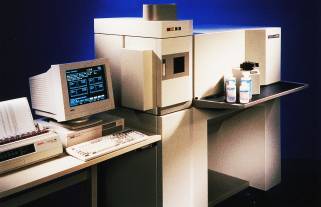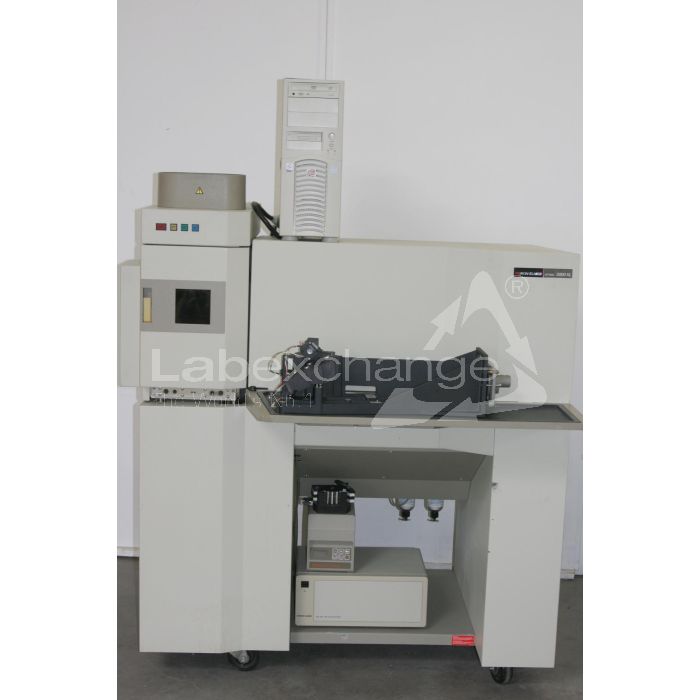Perkin Elmer Optima 3000 XL
| Objektnummer | B00024445 |
|---|---|
| Seriennummer | 024445 |
| Nome oggetto | Perkin Elmer Optima 3000 XL |
| Stato | Archived Product |
Gruppo prodotti: ICP-Systems
Status, terms of delivery and payment
Verification of devices
The second-hand devices are verified by Labexchange Service GmbH before delivery. You are receiving only fully functional devices.
Dispatch time
The stated dispatch times are the shortest possible ones for each article. The effective dispatch times can vary. The effective dispatch times will be stated in the order confirmation.
As a matter of principle, we are offering collective deliveries. The shipping time is calculated based on the position with the longest lead time. A partial delivery is possible on explicit request.
Shipping methods
Parcel services, forwarding agencies, self-pickup, delivery by Labexchange fleet.
Delivery information
Prices exclude shipping costs. Stated shipping costs are to be expected. Deviations are possible. If transport costs are not specified, please ask separately for them.
The stated transport and packing charges apply to the most favorable route if transport and are to be understood as subject to verification due to unexpected cost increases. By reason of unpredictable events, cargo rates and delivery times can change at any time and therefore have to be adapted to the recent situation. Import formalities and possible customs charges will be borne by the purchaser. Incoterm coding according to Incoterms 2010: For persons who collect the devices themselves: EXW, for dipatch by sea: CFR, by air freight: CPT, other shipments: DAP. Note for international shipments: A proof of preference/EUR1 will not be issued by us. When self-collecting/ordering EXW from countries within or outside the European Union, 16% VAT will be retained as a deposit until we have received the corresponding confirmation of arrival/bill of delivery from the buyer.
Terms of payment
We do not accept payment by letter of credit, PayPal, etc. In each case the invoice amount is payable without deduction. Discount is not granted.
|
Country |
Possible payment methods |
Comment |
|
DE, AT, CH |
Payment by invoice, payment in advance, payment by credit card |
Payment by invoice is only possible for corporate clients. |
|
NL, BE, LU |
Payment by invoice, payment in advance, payment by credit card |
Payment by invoice is only possible for corporate clients |
|
Other countries |
Payment in advance, payment by credit card |
|
Our General Terms of Sale, Delivery and Payment are valid and are available for download here.
The goods are offered subject to prior sale.
Definition of status
All articles are used articles, except an article is listed especially as a new device.
|
Status |
Condition |
Comment |
|
Immediately available |
Used | The article is fully functional and in impeccable condition. It can be shipped immediately. |
| In stock |
Used |
The article is on stock. Our service technicians will verify the article before delivery. You are receiving only a fully functional article. |
|
Published |
Used |
The article is still with the provider. After your order the article will be purchased and verified by us before being shipped to you. A certificate of operativeness as well as a service report are included in delivery. |
|
New device |
new |
The article is brand new and unused. Regarding new equipment the guarantee/warranty conditions of the corresponding manufacturer apply. |
|
Labprocure |
Used |
Labprocure GmbH, as the advertiser, is responsible for the content of this device offer. Labprocure assumes liability for the offers advertised here and for the photos and offer texts included. Labprocure GmbH, Bruckstraße 58, 72393 Burladingen. |
Firma: Perkin Elmer
Nachfolgende Abbildungen und Beschreibungen sind modellbezogen und aus Prospekten entnommen.
Sie geben nicht den Lieferumfang des Systems wieder.
Den exakten Lieferumfang entnehmen Sie bitte aus dem Angebotstext.

Optima 3000XL ICP-Emissionsspektrometer
Vollautomatisch arbeitendes Emissionsspektrometer für die simultane Multielementanalyse von Lösungen mit ICP-Anregung. Für höhere Nachweisstärken wird ein axiales Plasma genutzt. Das System besteht aus einem Spektrometer einschließlich Polychromator, Probeneinführungssystem, HF-Generator, Steuerrechner mit Farbbildschirm und Drucker.
Optik
Der von Perkin-Eimer entwickelte optische Aufbau nutzt ein Gitter, das für den UV-Bereich optimiert wurde. Dieses Gitter weist 79 Linien/mm mit einem Blaze-Winkel von 63° auf. Um eine möglichst getreue Abbildung zu erzielen, wird das gestreute Licht in zwei Bereiche unterteilt-. Der sichtbare Bereich wird mit einem Prisma weiter unterteilt, während der UV-Bereich von einem Schmidt Cross Disperser zerlegt wird.
Der Schmidt Cross Disperser hat drei Aufgaben: (1) Durch ihn wird das Licht in UV- und VIS-Bereich unterteilt. Dies erfolgt mit einem Loch in der Mitte: das Licht in der Mitte gelangt ungehindert zum Prisma während (2) der UV-Bereich vom mit Linien versehenen Randbereich weiter dispergiert wird. (3) Eine weitere Aufgabe besteht darin, die spährische Aberation der Kamera-Ebene zu korrigieren. Diese Konstruktion bewirkt eine hohe Lichtausbeute und eine hervorragende Auflösung.
Der einzigartige optische Aufbau hat folgende Vorteile:
Die simultane Messung der analytischen Linie und des Untergrundes führt zu verbesserter Präzision und höherem Analysendurchsatz. Eine Auflösung von < 7 pm im unteren UV-Bereich. Eine sehr hohe UV-Quantenausbeute führt zu verbesserten Nachweisgrenzen. Ein hoher dynamischer Bereich umfaßt Konzentrationen von ppb bis %. Random access readout bedeutet: alle Subarrays können einzeln gelesen werden, um ein Maximum an Flexibilität zu erzielen. Die Detektoren werden auf -40°C gekühlt, was zu einem sehr niedrigen Dunkelstrom führt. Die Isolierung und Thermostatisierung der Optik bei 38°C führt zu einer hervorragenden Wellenlängenstabilität.
Probeneinführungssystem
Das Probeneinführungssystem ist leicht zugänglich: Zwei Türen, eine vorn, eine an der Seite, ermöglichen einen guten Zugang zum Probeneinführungssystem, das als Schnellwechseleinheit eingesetzt ist. Die Vordertürenthältein FensterzurBeobachtung des Plasmas. Sicherungseinrichtungen überwachen das querliegende Plasma.
Das Probeneinführungssystem besteht aus einerzerlegbaren Fackel (das äußere und mittlere Rohr sind fest miteinander verbunden, um ein stabiles Plasma zu gewährleisten), einem Aluminiumoxid-Injektor, einer RytonSprühkammer (beständig gegen alle gebräuchlichen Aufschlußsäuren einschl. Flußsäure und Königswasser sowie organische Lösungsmittel).
Die zerlegbare Fackel enthält standardmäßig einen Aluminiumoxid-Injektor mit 2 mm Innendurchmesser. Verschiedene Innendurchmesser sind aus Aluminiumoxid und Quarz verfügbar. Der Abstand des Injektors kann relativ zur HF-Spule justiert werden.
Ein Cross-Flow-Zerstäuber mit Ryton-Endkappe und Aluminiumoxid-Düseneinsätzen wird als Standard-Zerstäuber eingesetzt. Weitere Typen (Meinhard, Sharp-Cone-Spray, van-der-Plas, Ultraschall) sind als Option erhältlich. Das Zerstäuber-Gas wird durch einen software-gesteuerten Mass-Flow-Controller reguliert.
Eine Computer-gesteuerte Drei-Kanal-Hochpräzisions-Schlauchpumpe dient der Probenzuführung und dem Abpumpen des Ablaufs (der dritte Kanal kann für Sonderanwendungen genutzt werden).
Hochfrequenz-Generator
Ein freilaufender 40-MHz-Generator dient zur Leistungseinkoppelung in das Plasma. Ein freilaufender Generator reagiert trägheitslos auf Laständerungen im Plasma durch Frequenzverschiebung. Die Leistung kann mittels Software im Bereich zwischen 750 und -1500 VV in Intervallen von 5 VV eingestellt werden. Die Leistung wird in einem Regelkreis (True Power Control: TPC) geregelt.
Der HF-Generator nutzt eine luftgekühlte Keramik-Leistungsröhre, die elektronisch, thermisch und mechanisch stabil ist. Sie wurde konzipiert, um eine hohe Zuverlässigkeit, lange Lebensdauer und eine einfache
Wartung zu vereinen. Um die Lebensdauer zu erhöhen wird der Heizstrom (tube filament) abgeschaltet, wenn die Röhre nicht benutzt wird. Die HF-Abschirmung entspricht den FCC- und VDE-Richtlinien.
Computer und Drucker
Die Optima 3000-Software verwendet den DEC-Rechner 466d2LPv und den EPSON-Drucker LQ-870. Die Funktion der Software wird nur in dieser Konfiguration gewährleistet.
Personal Computersystem DECpc 466d2LPv mit ISA-Bus, 80486d2 32-Bit Prozessor, 66 MHz, 8 MB Speicher (max. 64 MB), 3S-805 Graphikprozessor mit 1 MB DRAM, 426 MB SCSI Festplatte, 525 MB SCSI Bandlaufwerk, 3571,44 MB Diskettenlaufwerk, 2 freie 16-Bit Steckplätze. Schnittstellen parallel und 2 seriell. Farbmonitor 17, Länderkit und Tastatur.
EPSON LQ-870-Matrixdrucker mit 24 Nadeln, 80 Zeichen/Zeile, bis 300 Zeichen/sec-, bis 90 Zeichen/sec in Schönschrift; Graphik mit 360 Punkten/ Zoll Auflösung, RS-232C- und Centronics-Parallel-Schnittstellen und Centronics-Anschlußkabel.
Software-Paket
Enthält Optima 3000 Software, UNIX-Betriebssystem für DEC-Rechner, Optima 3000 Handbücher, Overlay, IEEE-488 Kabel, 3,5"-Leerdisketten und Druckerpapier.
Die Optima 3000 Software ist multitaskingfähig. Sie ermöglicht ein Höchstmaß an Flexibilität und eine einfache Bedienung. Das Software-Konzept ermöglicht sowohl eine einfache Routineoperation wie auch eine ausgefeilte Methodenoptimierung. Einige Merkmale der Software sind-.
Standardbedingungen und -einstellungen-, globale Änderungen eines ausgewählten Datensatzes: Wellenlängenbibliothek mit 50.000 Einträgen; Speicherung und Darstellung von Spektren; hochauflösende Graphik; automatische Zentrierung des Analytkanals auf der optischen Achse des Spektrometers-, Piktogramme zur Zustandsanzeige des Spektrometers; Interelement-Korrektur und multiple interne Standards.
Weitere, hochentwickelte Software-Merkmale sind:
Auto-Integrationszeit-Bestimmung: Hiermit wird vor Beginn der Messung die Integrationszeit fürjedes einzelne Subarray dem emittierten Licht in diesem Wellenlängenbereich angepaßt, so daß eine optimale Zählstatistik resultiert. Die automatische dynamische Untergrundkorrektur legt die Untergrundkorrekturpunkte anhand der spektralen Störungen bei jeder einzelnen Wiederholung und jedem Subarray individual fest. Neuberechnung einerAnalyse mit geänderten Parametern (z.B. korrigierte manuell gesetzte Untergrundkorrekturpunkte oder Standardkonzentrationen) mit Hilfe von gespeicherten Spektren, ohne daß die Lösungen neu gemessen werden müssen. Die Optimierung mit Directed Search (gezielte Suche) unterstützt eine schnelle Methodenoptimierung. Multicomponent Spectral Fitting (MSF) dient zur mathematischen Filterung von spektralen Störungen. Quasi-Macro-Programmierung mit Hilfe von EXEC-Files dient der weitgehenden Automatisierung.
Kompressor (wahlweises Zubehör)
Zwei Kompressoren.
Probenautomat AS-91 (wahlweises Zubehör)
Computergesteuertes Probenaufgabesystem zur vollautomatischen, sequentiellen Multielementbestimmung mit spezieller Versorgungseinheit mit drei austauschbaren Probentabletts. Steuerung erfolgt über die Betriebssoftware des ICP Spektrometers. Auswechselbare Probentabletts mit 152 Probenpositionen für 15-mL-Probengefäße (im Lieferumfang enthalten) oder 218 Positionen für 6-mL-Gefäße oder 55 Positionen für 50-mL-Gefäße (Option) und eine Position für einen Waschbehälter, PTFEProbenkapillare mit 0,6-mm-Innendurchmesser.
Ultraschallzerstäuber CETAC U-5000AT (wahlweises Zubehör)
Zubehör zur ICP-AES und ICP-MS zur Steigerung der Empfindlichkeit und des Nachweisvermögens. Komplette Einheit, bestehend aus Ultraschallzerstäuber, Umlaufkühlung (benötigt 2.5 L Kühlmittel, z.B. Diethylenglycol) und Laborwagen.





